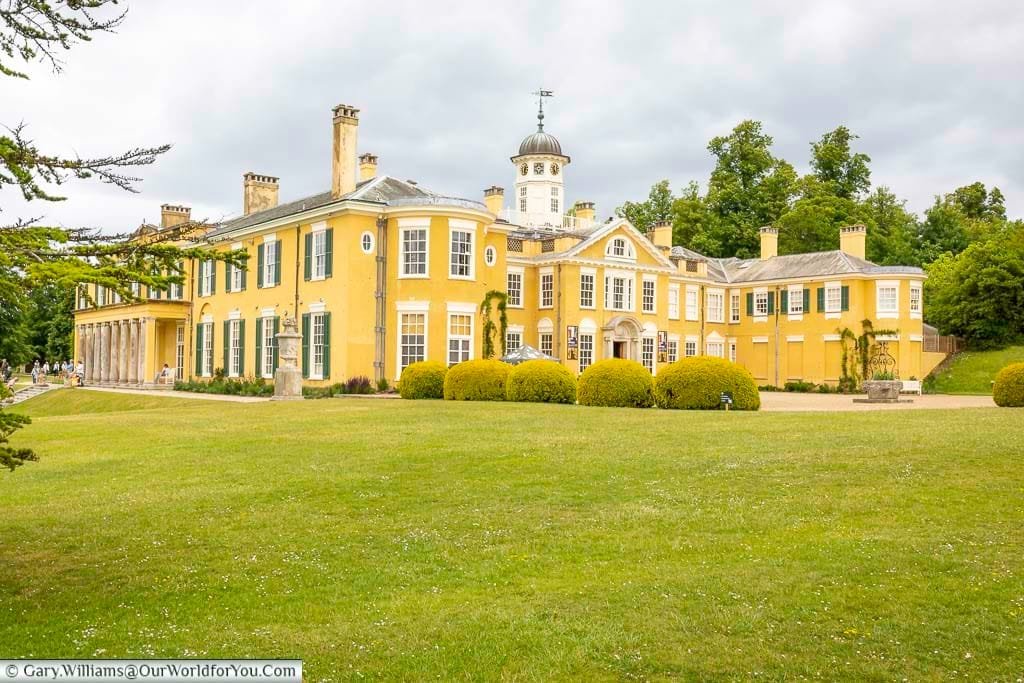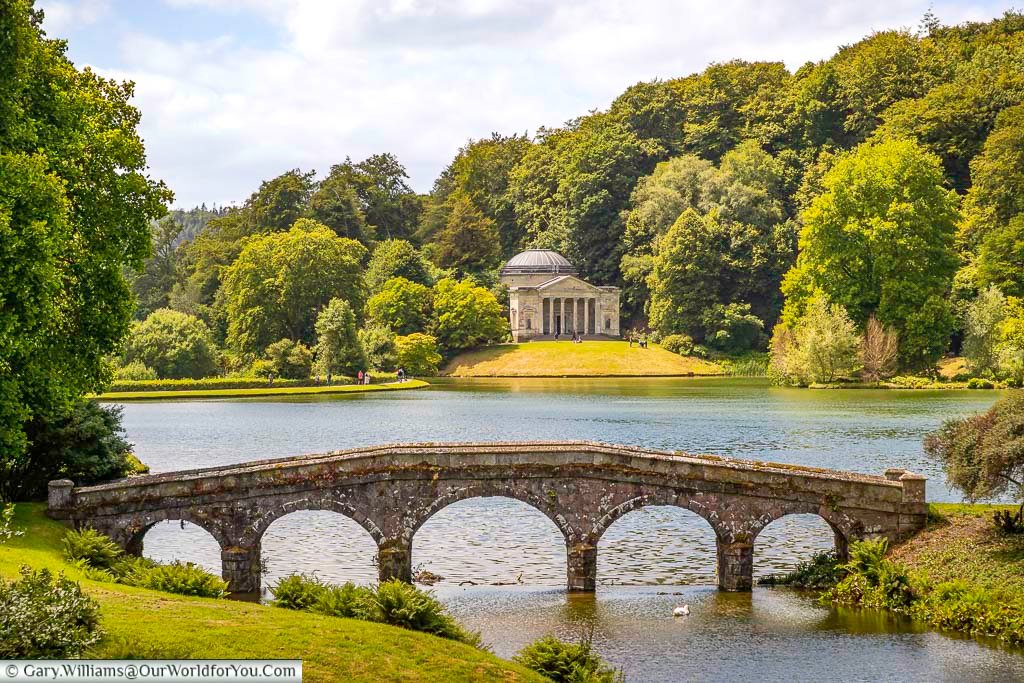900 years of history
Well, we’re certainly getting our money’s worth from our National Trust subscription again this year, as we’ve just visited the magnificent Petworth House in West Sussex.
Petworth House is just around 15 miles northeast of Chichester and is nestled inside a 700-acre deer park within the South Downs National Park. When you begin to stroll towards Petworth House, the hustle and bustle of daily life is left behind, and peace descends through the Pleasure Garden.
When you’ve explored the grand abode of Petworth House and stood in awe at the stunning works of art by Turner, Gainsborough, and Reynolds, to name just a few, ensure you allow time to discover the Upper Pond and Deer Park.
So, let’s grab our National Trust cards and explore Petworth House.

Where is Petworth?
How to get to Petworth
- By Train
The nearest train station to Petworth is Pulborough, which is 5¼ miles away. The No. 1 Stagecoach bus service between Worthing and Midhurst passes Pulborough train station.
- By Car
The Main Car Park for Petworth House, is located on the A283. If you wish to access Petworth Park, follow the signs to the North Car Park.
There’s a free car park for National Trust members; parking charges may apply to non-members.
Petworth House postcode is GU28 9LR ///unusable.candidate.consoled or you can find it by using What3words ///padlock.thud.solve
A little bit of history on Petworth House
900 years within the same family
Petworth House has remained a Percy family home for over 900 years, with the land being granted to them as a Royal gift by the widow of Henry I. The powerful Percy family were from the north of England and used Petworth during their visits south.
In the late 16th century, Queen Elizabeth I, suspected that the family had loyalties to Mary, Queen of Scots and banished them to Petworth. This is when Petworth House gradually evolved into the grand mansion you see today.

Petworth’s transformation occurred in the late 1600s when Charles Seymour, the 6th Duke of Somerset, married the heiress of Petworth, Elizabeth Percy. They became one of the wealthiest and influential couples in England. Petworth House was to become an enviable residence compared to the majestic palaces being built throughout Europe.
Although Petworth was to become an imposing 17th-century mansion, evidence of the original medieval manor can still be seen, as the beautiful chapel has survived.

The 3rd Earl of Egremont inherited Petworth in 1763. He was a passionate collector of British works of art, particularly those of the artists J.M.W. Turner and John Constable, who were regular guests at Petworth House. This era in Petworth was known as its “Golden Age’.
In 1947, Petworth House was bequeathed to the National Trust by the 3rd Lord Leconfield due to heavy death duties. Later, part of the extensive art collection was also donated to the National Trust. Today, an area of Petworth House remains private as the current Lord and Lady Egremont reside there.
Stay informed
The Lower Path to Petworth House
Meandering through the Pleasure Garden
It’s certainly worth taking both routes as there’s something different to be found along each winding pathway. We give the beehives a wide berth to let them continue making honey and stroll past the cute little Shepherd’s Hut.
The walk towards Petworth House through the Pleasure Garden is very peaceful, meandering past blooming flower beds with a mixture of full sun and dappled shade.


Where to stay near Petworth
Exploring Petworth House
A family through the centuries



We’ve now moved into the splendid Square Dining Room, which is full of family portraits covering seven generations. The dining room used by the 6th Duke was on a much larger scale; this room was built around 1795.
The Square Dining Room is also home to a large, imposing painting by Sir Joshua Reynolds, Macbeth and the Witches, which was unfinished.


We stroll into The Marble Hall, which until the 1870s was the main entrance to Petworth House. Conservation work was carried out on the Marble Hall floor in 2017 to relay tiles which had come loose.
The Marble Hall houses a piece of art by Titian called ‘An Unknown Cardinal’. The painting was initially downgraded to ‘in the manner of Titian’; however, in 2019, it was confirmed to be a genuine portrait by Titian.
If, like us, you enjoy visiting the National Trust gardens around the United Kingdom, then grab yourself a copy of the latest ‘Gardens of the National Trust’.
It’s a beautifully illustrated book, and it won’t be long before you’re planning your next trip.
Petworth Beauties
The Grand Staircase
Two hundred years ago, the 3rd Earl of Egremont began to run out of wall space, so, he ordered that six of the eight Petworth ‘Beauties’ be cut down to three-quarter length and lose their feet. Luckily, rather than discard the lower portion, this was attached to the back of the painting.
The National Trust restored two of the paintings in 2019 to their full length and went on display at an exhibition in Tate Britain. Work will continue to restore the remaining portraits



The French painter Louis Laguerre was commissioned by the Duke for £200 to paint the murals all around the entire room, even on the ceiling. The sheer scale of the murals are incredible and they have so much detail and passion in them.
We visited Petworth House on a Wednesday morning when some of the private bedrooms used by Lord and Lady Egremont were open to the public for a few hours. Photos were not allowed in this part of the house.
Map, guides and more
Nymans is located in the lush county of West Sussex. This region of England, along with the South Downs and the Wealden countryside, is perfect for hikes. To explore the delightful circular walks in this region, you’ll want the Ordnance Survey Pathfinder guidebook no. 66.
Alternatively, why not purchase and download the OS Maps App, which covers all of Great Britain.
The Carved Room in Petworth
A touch of elegance



During the late 1600s, when the 6th Duke of Somerset resided at Petworth House, the Red Room showcased 60 magnificent paintings.
From 21st June to 16th November 2025, there is a separate Turner exhibition being held at Petworth House, named ‘Turner’s Vision at Petworth’; there is an additional charge for this event.
Discovering more National Trust gardens
Visiting the North Gallery
Stepping into the Baroque Chapel




With my love of everything to do with maps and globes, I was instantly drawn to the Molyneux terrestrial globe. This globe is now the only surviving first edition and was made in 1592 by the mathematician Emery Molyneux. With a closer look, you’ll see the stunning engravings.
The globe is now housed in its own glass cabinet for its ongoing protection.



Petworth Chapel was altered by the 6th Duke of Somerset in the late 1600s, adding many Baroque inspirations, including carved cherubs. The chapel is beautifully preserved and certainly a change of style compared to the rest of the grand, elegant house.
During our visit to Petworth House, the servants’ quarters and the historic kitchens were closed, which just means we’ll have to return once again to admire this magnificent home.
Escape for a few days
Are you in search of a tranquil hideaway to relax and unwind in, while you discover the beautiful British countryside?
Browse through the handpicked properties and unique retreats at Holiday Cottages.
Strolling in Petworth Park
700-acre Deer ParkWe’re now going to head off through the iron Tijou Gate beside the house for a stroll around the Upper Pond, and along the edge of the 700-acre Deer Park. The circular route is approximately 1½ miles.
It was a pretty hot day at Petworth, so it was going to be a slow amble through the park.


It’s a lovely walk around the pond; it’s very peaceful, other than the occasional presence of a few families of geese. The route is a mix of sun and shade, so be sure to take some water with you. Also, whilst ambling around the pond, you’ll spot the old stone boat house.
Unfortunately, we didn’t spot any deer at Petworth. However, if you have an urge to visit another deer park, we can highly recommend Knole House; I can almost guarantee you’ll see deer.

As we wend our way back towards the exit, we head a different way back to admire the Pleasure Garden, which the English gardener and landscape architect Capability Brown also designed.
The eye-catching Doric Temple once stood within the Deer Park and was relocated by Capability Brown in the 1750s to the Pleasure Grounds. In 1875, it was relocated once again to its current site and serves as a memorial to Henry Scawen Wyndham, who died at El Alamein during World War II.

Our final stop of the day was to Petworth’s Rotunda, which has beautiful far-reaching views across the Sussex countryside. The charming Rotunda was built in 1766 and is modelled after the Temple of Vesta in Tivoli, Italy.
Go on, grab your National Trust membership card, and visit Petworth in West Sussex.
* This post may contain links to affiliated sites where we earn a small commission at no additional charge to you.




